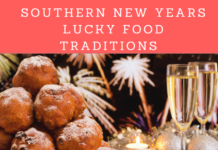New Years means a lot of different things to each of us. For many, it is a time for reflection, renewal, and to set new goals. A new, blank calendar can symbolize a new chapter in life waiting to be written. A new year brings fresh opportunities to grow, see the world from new perspectives, and manifest blessings.
That being said, much folklore has been passed down throughout the years all around the world on New Year traditions and Superstitions. Some cultures believe that what you eat and what you wear could determine whether or not you have a good year. You can find a very detailed post on New Years Lucky Foods as well as New Years Lucky Food Menu Ideas, by clicking on the highlighted links.
For this post, we thought we would have some fun and give you our list of Lucky Foods Worth Traveling For.
Collard Greens in the American South
The American South is home to stunning coastal cities like Charleston and Savannah, where you can explore antebellum architecture, vibrant food scenes, and rich African-American history. While in Charleston, why not shop for Antiques, tour Historic Private Homes and Gardens, and enjoy the Art galleries, religious sites, and the famous waterfront district? Savannah offers plenty of charm, Civil War history, food & ghost tours, plantation and historic home tours, as well as a busy waterfront.
When visiting the low country this New Year’s, be sure to try Hoppin’ John, a stew of field peas and rice. The peas represent coins, and the rice expands as it cooks, denoting financial expansion in the coming year. This dish encompasses multiple prosperity traditions, served alongside flavorful collard greens stewed with pork, Cornbread, and collard greens. Hoppin’ John is made of black-eyed peas and rice cooked with bacon, fatback, or ham hock. It is thought that eating pork will mean your wallets will be fatter in the new year! The pig also roots forward and can’t turn its head backward, which represents moving forward in the New Year. Pork is also used in the collard greens for the same reason. Beans and rice swell when you cook them, which symbolizes prosperity in the new year.
Fufu in Ghana
Known as the “Gateway to Africa,” Ghana welcomes visitors with palm-fringed beaches, poignant slave castles, and energetic cultural festivals. Ghanaians eat the staple doughy paste called fufu on New Year’s Day. Made by pounding cassava and green plantain flour, this stretchy, starchy food represents prosperity, abundance, and endurance in the new year.
Thieboudienne in Senegal
The capital city of Dakar boasts a stunning coastal location and pulsating nightlife. Venturing beyond reveals wildlife reserves, pink lakes, colonial towns, and remote artists’ villages. Senegalese cook Thieboudienne to ring in the new year – a fragrant dish of fish, rice, and vegetables that symbolizes blessing the year ahead with abundance.
Injera in Ethiopia
From the rock-hewn churches of Lalibela to the wondrously strange land formations of the Danakil Depression, Ethiopia was enthralled with a landscape unlike any other. Ethiopians make and share injera flatbreads on New Year’s day. The spongy sourdough carries wishes of peace, harmony, and fellowship in the community in the year ahead.
Bunny Chow in South Africa
South Africa’s vibrant patchwork of cultures and awe-inspiring landscapes never cease to amaze visitors. Urban highlights like Cape Town and Johannesburg combine cosmopolitan energy with natural beauty, from soaring tabletop mountains to rolling vineyards. On New Years, South Africans dish up bunny chow, a hollowed-out loaf of bread filled with hot curry. This comforting, carbo-loaded meal provides sustenance and security for the year ahead.
Ugali in Kenya
Kenya entices safari-goers with its legendary wildlife gatherings, from great migrations in the Maasai Mara to millions flamingos turning Lake Nakuru rosy pink. Kenyans celebrate the coming year by eating ugali, a stiff maize porridge. This filling, starchy staple promises to stick to one’s ribs and provide endurance in the year to come.
Soba Noodles and Mochi in Japan
Japan offers travelers a wealth of cultural treasures and historical sites, stunning natural beauty, active options such as hiking, winter sports, and golf, entertainment of all sorts – from highbrow kabuki and classical music to karaoke, great shopping, a rich culinary tradition, and much more. Soba noodles are eaten on New Year’s Eve in Japan. Made from buckwheat flour, they signify long life, strength, and resiliency, but no cutting them as it is thought that will cut the luck from the New Year, so slurp away! In Japan, celebrants ring in the new year by eating ozoni, a soup containing mochi, or sweet rice cakes. Their stretchy texture symbolizes flexibility and longevity. Japan boasts technologically advanced cities like Tokyo and cultural epicenters like Kyoto. Beyond the cosmopolitan metropolis, you’ll find quiet towns dotted with tranquil shrines and temples, undulating hills, and picturesque countryside brimming with hot springs.
Vasilopita and Pomogranate in Greece
Greece and its incredible islands should be on everyone’s bucket list! Greece is one the most popular vacation destinations in the world, and for good reason: the landscape offers a picturesque variety, and its cuisine will reward even the most demanding visitors. It is also a country with a great and ancient history, one that gave birth to the Olympic Games, the concepts of democracy and philosophy, and ancient Greek drama. The Greek islands of Santorini and Mykonos have become wildly popular destinations in recent years thanks to their picturesque white-washed buildings perched on cliffs overlooking azure waters. But the Greek mainland also has much to offer, from the famed Acropolis in Athens to the oracle site at Delphi nestled amidst olive tree-dotted hills. What could be luckier than a cake with a coin hidden inside? Vasilopita is a cake served on New Years throughout Greece. It represents prosperity, particularly for the person who gets the slice with the coin in it. For extra luck, top it with pomegranate seeds. Locals celebrate the new year by breaking open a ruby-red pomegranate, wishing for abundance and joy in the coming year to seed the months ahead.
Black Eyed Peas in Cuba
Lentils resemble little coins. On New Year’s Day, Cubans (as well as several South American countries) eat lentils and rice, or lentil soup, to ensure good fortune in the year to come. The lively island of Cuba beckons with salsa music, classic cars, and white sand beaches. On New Year’s day, locals consume moros y cristianos, a hearty dish of black eyed peas, rice, and pork. The peas and rice mimic the appearance of coins and swell as they cook, promising financial prosperity in the coming year. From the electric nightlife of Havana to the Valley of Viñales’ lush tobacco fields, Cuba offers vibrant culture and scenery.
Lentil Soup in Brazil
Brazil’s sprawling cities, captivating music, and rich Afro-Brazilian culture make it an exciting New Year’s destination. Ring in 2024 by sipping a bowl of green lentil soup, believed to signify prosperity in the coming year. The round lentils resemble coins, and the green color represents new beginnings. From the colorful mosaic sidewalks of Rio de Janeiro to Salvador’s Afro-Brazilian beats, Brazil promises vivid sights and sounds as you welcome the fresh start of a new year.
Tamales in Mexico
Experience aquamarine waters, gleaming beaches, delectable cuisine and invigorating nightlife in the Caribbean. Or soak in Mexico’s rich land, dreamy landscape, the warmth of its people, and the past and the present in perfect harmony. If you are there for New Years, make sure and order tamales. Corn—the key ingredient of tamales—is the color of gold, symbolizing wealth. Tamales also represent love for the time and labor it takes to make them.
Grapes in Spain
Like fashion, travel destinations are in and out of style. Madrid’s renowned Prado art museum, the new America’s Cup Sailing Village in Valencia, and the amazing Guggenheim museum in Bilbao. The country is attracting foodies, too, with its modern twist on classic food and Spain’s growing reputation for wines. Yes, of course, we have grapes here, but their color, texture, and taste do not compare to those of Spain. In Spain, the new year is ushered in by eating twelve grapes at midnight—one for each month. Sweet grapes foretell pleasant months ahead, while sour ones predict challenges. Every Spanish city overflows with culture, from the winding alleys of Barcelona to the museums and cafés of Madrid. And the wine flows freely through bustling tapas bars and family-run bodegas.
Wherever you go, whatever you do, we wish you a very Happy and Healthy New Years!














